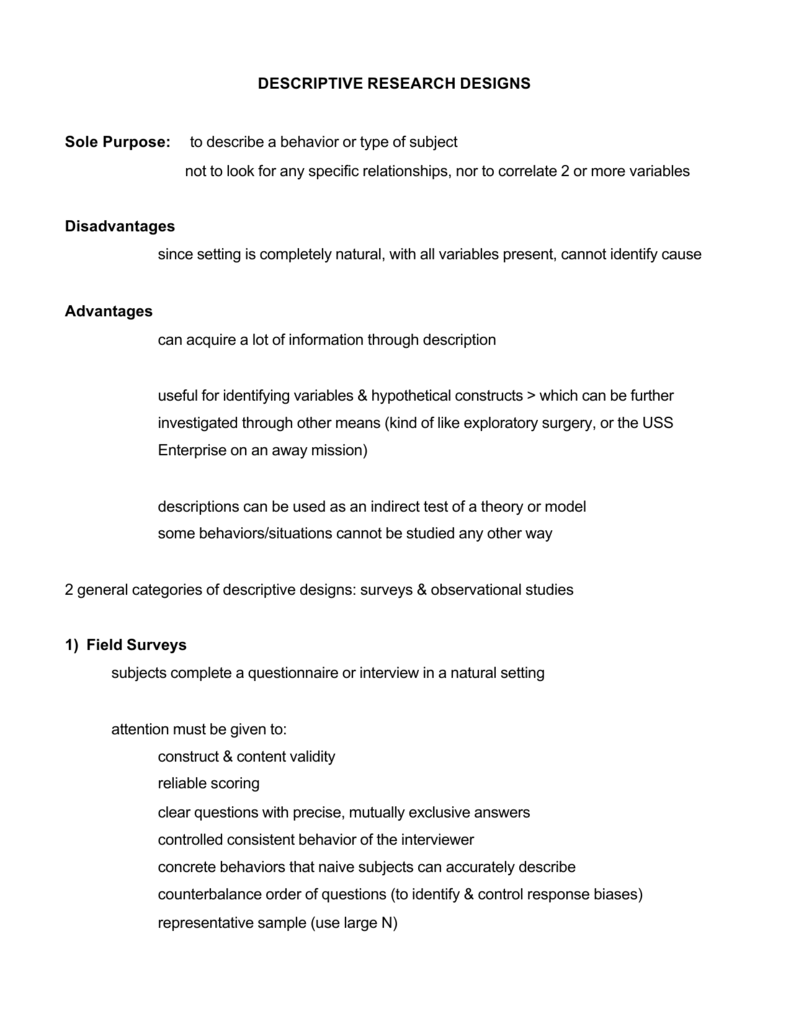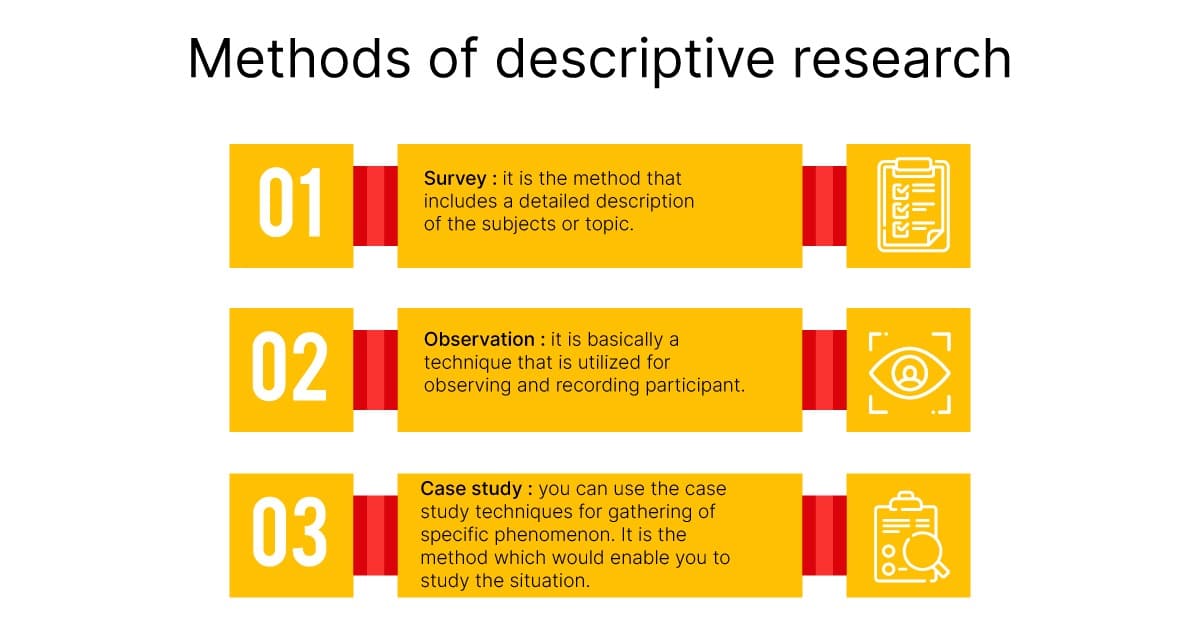Table Of Content
- Descriptive Research Designs: Types, Examples & Methods
- Colorful Adjective Examples Worth Considering
- Step-3: Define the target population and sample group
- Characteristics of descriptive research
- Voxco offers easy-to-use online survey tools with robust features to create interactive and engaging surveys.
- Data Analysis

Sample size calculation should be an estimate until saturation has been achieved through the concurrent processes of data collection and analysis. Where saturation has not been achieved, or where sample size has been predetermined for resource reasons, this should be clearly acknowledged. However, there is also a movement away from the reliance on data saturation as a measure of sample size in qualitative research (Malterud et al., 2016).
Pittsfield Board Sees Potential Creative District Design Guidelines - iBerkshires.com
Pittsfield Board Sees Potential Creative District Design Guidelines.
Posted: Fri, 07 Apr 2023 07:00:00 GMT [source]
Descriptive Research Designs: Types, Examples & Methods
Because of the flexibility of the methods used, a descriptive design provides the researcher with the opportunity to choose methods best suited to a practice-based research purpose. Verbatim transcripts were thoroughly reviewed to develop an overall understanding of the participants’ statements. Meaningful words and paragraphs related to the factors that had facilitated the retention of these re-entry nurses were extracted, and codes were assigned to represent the symbolic meanings of the data segments (first-cycle coding). Subsequently, the codes were compared and contrasted to group them into categories based on their similarities in meaning. These categories were further integrated into themes that captured the essence of the factors facilitating the retention of nurses who returned to the nursing workforce (second cycle coding). The first-cycle coding was conducted by the first author (KY) by utilizing her understandings of the participants’ context and their experiences.
Colorful Adjective Examples Worth Considering
Therefore, family-friendly working conditions (e.g., flexible hours, location, childcare support) are vital for returning and sustaining work. This finding is consistent with previous studies indicating that workplace flexibility, which helps alleviate childcare concerns, is crucial for enabling nurses to sustain their work [28, 30, 35, 36]. Furthermore, nurses who juggle dual caregiving roles often experience fatigue and stress [44].

Step-3: Define the target population and sample group
Furthermore, having a job established a consistent rhythm to their lives and facilitated physical fitness, thus promoting a balanced existence. They also perceived the involvement of others in caring for their children as an opportunity for their children to interact with a broader network of individuals, fostering their growth and healthy development. Moreover, the up-to-date medical knowledge gained through their work served to safeguard the health of their families. The participants emphasized the significance of being recognized and accepted by their colleagues and supervisors. The acknowledgment of their efforts by supervisors and the understanding of their hard work by colleagues served as encouragement to sustain their work.
Case studies allow researchers to create hypotheses that can widen the scope of evaluation while studying the phenomenon. However, it is important to note that case studies cannot be used to outline the cause-and-effect relationship between variables as they cannot make accurate predictions due to the risk of researcher bias. The data collected in descriptive research provides a base for further research as it helps obtain a comprehensive understanding of the research question so that it can be answered appropriately. Descriptive research design is a type of research design that aims to systematically obtain information to describe a phenomenon, situation, or population. More specifically, it helps answer the what, when, where, and how questions regarding the research problem rather than the why. Descriptive research design aims to systematically obtain information to describe a phenomenon, situation, or population.
Research in Psychology: Methods You Should Know - Verywell Mind
Research in Psychology: Methods You Should Know.
Posted: Tue, 05 Dec 2023 08:00:00 GMT [source]
Characteristics of descriptive research
While there are a number of descriptive research methods you can deploy for data collection, descriptive research does have a number of predictable characteristics. For example you could use descriptive research to understand fashion trends in a given city when planning your clothing collection for the year. Using descriptive research you can conduct in depth analysis on the demographic makeup of your target area and use the data analysis to establish buying patterns. This method involves comparing data across different groups or time periods to identify similarities and differences.
Ensure adequate sample size

Surveys are a type of descriptive research that involves collecting data through self-administered or interviewer-administered questionnaires. Additionally, they can be administered in-person, by mail, or online, and can collect both qualitative and quantitative data. Furthermore, these studies often do not face serious ethics scrutiny, except if the information sought to be collected is of confidential nature (e.g., sexual practices, substance use, etc.).
Voxco offers easy-to-use online survey tools with robust features to create interactive and engaging surveys.
Engaging in discussions about personal life with managers or other returners may prove beneficial in this regard. As with any research design, ensuring the rigor or trustworthiness of findings from a qualitative descriptive study is crucial. For a more detailed consideration of the quality criteria in qualitative studies, readers are referred to the seminal work of Lincoln and Guba (1985) in which the four key criteria of credibility, dependability, confirmability and transferability are discussed. At the very least, researchers need to be clear about the methodological decisions taken during the study so readers can judge the trustworthiness of the study and ultimately the findings (Hallberg, 2013).
Some subjects cannot be observed in any other way; for example, a social case study of an individual subject is a descriptive research design and allows observation without affecting normal behavior. It is distinctive because it can use quantitative and qualitative research approaches at the same time. Organizations use descriptive research designs to determine how various demographic groups react to a certain product or service.
Furthermore, perceiving themselves as individuals who were relied upon by others and striving to meet those expectations facilitated their professional growth and their desire to contribute to the workplace. The participants also emphasized the need for a family-friendly work environment, where colleagues and supervisors understood their family circumstances and provided support in balancing work and family duties. Therefore, effectively managing childcare duties while fulfilling work roles became a priority in their lives. Access to childcare facilities was deemed a basic requirement for them to work, as well as conditions such as workplaces located close to their homes and offering flexible working hours to address child-related matters promptly. Among her interests are artificial intelligence, machine learning, and natural language processing. As a humanitarian and educator, she actively supports women in tech and promotes diversity.
Comparative analysis can help describe changes in attitudes or behaviors over time or differences between subgroups within a population. Descriptive research aims to describe and document the characteristics, behaviors, or phenomena of a particular population or situation. It focuses on providing an accurate and detailed account of the existing state of affairs. Descriptive research provides a detailed and comprehensive account of a specific situation or phenomenon. It focuses on describing and summarizing data without making inferences or attempting to explain underlying factors or the cause of the factor.
For example you could gather detailed data about a specific business phenomenon, and then use this deeper understanding of that specific case. Because the elements needed for descriptive research design are not specific or highly targeted (and occur within the respondent’s natural environment) this type of study is relatively cheap to carry out. Descriptive research aims to accurately and systematically describe a population, situation or phenomenon. Descriptive studies are useful for estimating the burden of disease (e.g., prevalence or incidence) in a population. For instance, information on prevalence of cataract in a city may help the government decide on the appropriate number of ophthalmologic facilities.

No comments:
Post a Comment